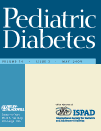Dermatological side effects and complications of continuous subcutaneous insulin infusion in preschool-age and school-age children
Abstract
Objective: The objective of this study was to evaluate whether very young children develop more dermatological complications during insulin pump treatment compared with school children.
Study design: Cross-sectional study in 78 consecutive children using insulin pump treatment >4 months.
Results: Children in group A [n = 40, 28 males (M) and 12 females (F)] were 2.3 ± 1.3 yr (±SD) and those in group B (n = 38, 13 M and 25 F) were 11.0 ± 2.9 yr old at the start of continuous subcutaneous insulin infusion (CSII). The mean duration of CSII was similar in both groups (23.6 ± 16.5 months in group A and 21.8 ± 16.1 in group B). The most common dermatological complications were scars <3 mm (50% in group A vs. 71% in group B, p < 0.05) and lipohypertrophic areas at the insertion sites (45% in group vs. 47% in group B). Local abscesses and blisters were rare findings in both groups (7.5–12%), none leading to interruption or stop of CSII.
Conclusions: Dermatological side effects during CSII are not more frequent or severe in very young diabetic children compared with diabetic children in school age.




